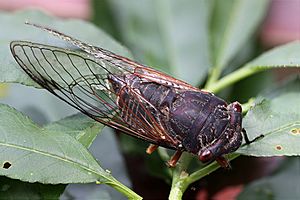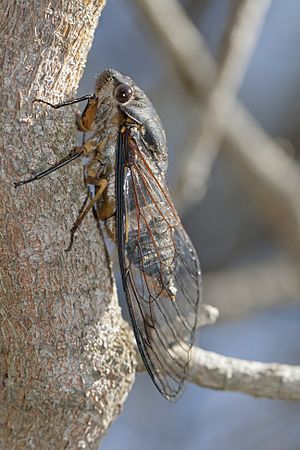Psaltoda plaga facts for kids
Quick facts for kids Psaltoda plaga |
|
|---|---|
 |
|
| Scientific classification | |
| Kingdom: | |
| Phylum: | |
| Class: | |
| Order: | |
| Family: |
Cicadidae
|
| Genus: |
Psaltoda
|
| Species: |
P. plaga
|
| Binomial name | |
| Psaltoda plaga (Walker)
|
|
| Synonyms | |
|
Cicada argentata Germar, 1834 |
|
Psaltoda plaga is a type of cicada that lives in eastern Australia. You can find them from Queensland down to New South Wales. These adult cicadas appear during the summer months. They like to live in forests near water. The dark, mostly black cicadas from the Sydney area are often called the black prince. The name silver knight is used for the species as a whole, especially for its lighter colored forms.
Contents
About the Black Prince Cicada
The black prince cicada was first described in 1834 by a German scientist named Ernst Friedrich Germar. He called it Cicada argentata. The word argentata comes from the Latin word for "silver." Later, another scientist, Carl Stål, created a new group of cicadas called Psaltoda in 1861. The black prince was placed in this new group.
Another scientist, Francis Walker, gave it the name Cicada plaga in 1850. Because the name Cicada argentata was already used for a different European cicada, the black prince eventually became known as Psaltoda plaga.
The name "black prince" has been used by people since at least 1923. It describes the darker cicadas. The name "silver knight" is used for the cicadas that are more olive or green in color.
What Does It Look Like and Sound Like?
The color of an adult male black prince cicada can change. It depends on how old it is and where it lives. Around Sydney, these cicadas are very dark, mostly black. They have some brown marks. Their eyes are brown.
Further north, like near Brunswick Heads, the black prince cicadas have more green marks instead of brown. They look lighter overall. Female cicadas are similar to males but are a bit smaller.
The black prince cicada makes two main sounds. One is a rhythmic revving sound. You hear this more when the weather is cooler. The other is a continuous call. This sound is more common when it's hot outside.
Where Do Black Prince Cicadas Live?
You can find the black prince cicada in eastern Australia. They live from Maryborough in Queensland down to Bega in New South Wales. Sometimes, huge numbers of these cicadas appear in certain summers. They have been seen every year, mostly from December to March, in western Sydney.
These cicadas need permanent water nearby, like rivers or swamps. They like to live in trees such as broad-leaved paperbark, mangroves, and river sheoak. They also like rough-barked apple trees, English sycamore, and weeping willow trees. Black prince cicadas prefer to sit on branches rather than on the main tree trunk.
The Black Prince Cicada's Life Cycle
A black prince cicada spends about seven years underground. During this time, it is a nymph. It drinks sap from the roots of plants. Some plants it feeds on include weeping willow, river sheoak, and various eucalypts.
After seven years, the nymph comes out of the ground as an adult cicada. Adult cicadas live for about four weeks. During this time, they fly around, mate, and lay eggs. This happens over the summer.
In one study, many black prince cicadas came out of the ground over 10 to 15 days. This happened in late November to early December. At the busiest times, up to 300 cicadas would land on just one tree!
Who Eats the Black Prince Cicada?
Many animals like to eat the black prince cicada. The noisy friarbird is one of their favorite predators. These birds swallow the cicadas whole, head-first. Other birds like noisy miners, blue-faced honeyeaters, and magpie-larks also eat them.
Even birds that hunt at night, like the tawny frogmouth, eat black prince cicadas. Bearded dragons also eat the nymphs as they come out of the ground.
The cicada killer wasp (Exeirus lateritius) is another predator. This wasp stings the cicada, which makes it unable to move. The wasp then takes the cicada to its burrow. It lays an egg on the cicada. When the wasp larva hatches, it eats the cicada.
Black Prince Cicadas in Popular Culture
Kids often try to catch live cicadas by climbing trees. This can sometimes lead to broken arms in the summer! You can keep cicadas as pets for a short time in a shoebox. But it's hard to keep them for more than a day or two. This is because they need fresh sap from trees to eat.
Australian journalist Peter FitzSimons remembered how much kids valued the black prince cicada when he was young. He said it was worth "three cherrynoses, four floury bakers, five yellow mondays or a thousand green grocers." Even though kids thought they were rare, black princes were more common near rivers than in neighborhoods.
There was a story that chemists (drugstore owners) would pay a dollar for their wings. A cicada expert, Max Moulds, thinks this might be because Chinese immigrants valued them. This could have been for Chinese herbal medicine during the gold rush in the 1800s. They might have looked like a similar Asian cicada used in medicine.



